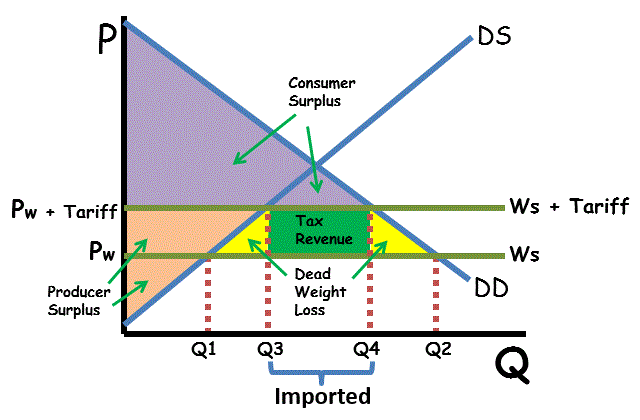Trade allows countries to specialize in goods where they have a comparative advantage, enabling them to produce at a lower opportunity cost and consume beyond their production possibilities curve (PPC).
- Absolute vs. Comparative Advantage:
- Absolute Advantage: Producing more with the same resources.
- Comparative Advantage: Producing at a lower opportunity cost (basis for trade).
- See 1.4 — Comparative Advantage and Trade
- Terms of Trade:
- Trade is beneficial when the price of traded goods falls between the opportunity costs of both parties.
- For example, if Country A gives up 2 units of wheat for 1 unit of cars, and Country B gives up 1 unit of cars for 3 units of wheat, trade benefits both if 1 car is exchanged for 2–3 units of wheat.
- Gains from Trade:
- Increases total output and consumption.
- Allows access to goods and services not domestically available or efficiently produced.
Public Policy in Trade
- Trade Barriers:
- Tariffs: Taxes on imports, raising their price. This protects domestic industries but reduces efficiency
- Quotas: Limits on the quantity of imports. This reduces supply, raising prices and benefiting domestic producers
- Subsidies: Government payments to domestic producers to lower costs and boost exports
- Arguments for Protectionism:
- Protects infant industries
- Safeguards jobs in domestic industries
- Ensures national security by reducing reliance on foreign goods
- Criticisms of Trade Barriers:
- Reduces overall efficiency and total surplus
- Can provoke retaliatory measures, leading to trade wars
- Limits consumer choices and raises prices
Graphical Representation
- World Price and Trade:
- World Price Below Domestic Price: Country imports the good, benefiting consumers but reducing producer surplus.
- World Price Above Domestic Price: Country exports the good, benefiting producers but increasing costs for consumers.
- Impact of Tariffs:
- Tariffs raise prices, reducing imports and creating deadweight loss.
- Consumer surplus decreases, while producer surplus increases.

International trade is fundamental to economic and equilibrium systems and is also largely discussed in relation to GDP within AP Macroeconomics. See 2.1 — Circular Flow Model and Gross Domestic Product (GDP).